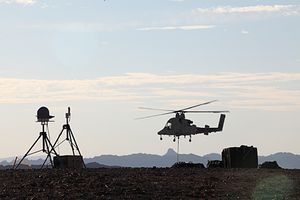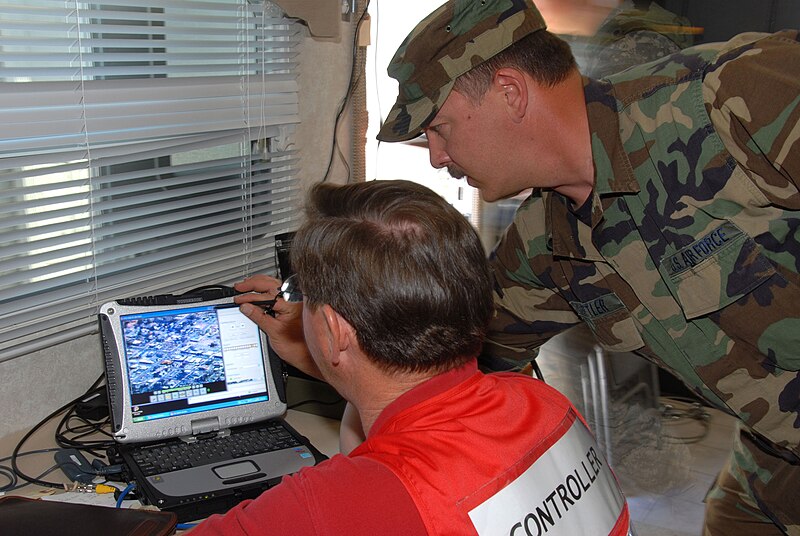U.S. Air Force photo by Tech. Sgt. Shelly Burroughs
November 26, 2011: STRATEGY PAGE
For the last two years, one of the most popular electronic gadgets in Afghanistan was not the iPad or satellite phone, but Rover 5, otherwise known as the fifth generation ROVER (Remote Operations Video Enhanced Receiver). This is small (14cm/5.5 inch wide) handheld video device provides ground troops with UAV video feeds. Each Rover 5 costs about $35,000 and is the size of a seven inch tablet. Rover is more than three times heavier than a tablet (at 1.6 kg/3.5 pounds). But Rover can still be hand held, and enables the user to direct the camera on the UAV supplying the video. A stylus is used for this. The additional weight in the ROVER is for all the electronics needed to receive a wide variety of signals and display several different video types, plus a larger battery. Rover 5s are more often mounted in vehicles, giving convoys a top-down view of the terrain ahead. This has made it more difficult to ambush American troops. Commanders use Rover 5 to check UAV feeds and their own troops.
ROVER allows troops to view real-time video from a UAV or aircraft overhead. Aircraft with targeting pods (like Litening and Sniper) or surveillance gear (like AC-130 gunships) are much more effective when the guys on the ground have a ROVER unit that can receive that video feed.
This kind of real-time, "common picture", capability makes air power much more effective, and reduces friendly fire incidents. U.S. Special Forces troops and infantry unit commanders use ROVER to obtain a larger view (than their low flying Raven UAVs can provide) of the surrounding area. This ROVER devices use a built in antenna to get the video from overhead UAVs or aircraft. The original ROVER system, as well as the current one, was developed and sent to the troops in record time. So don't let anyone tell you this sort of thing can't happen. However, except in wartime, such rapid technology development usually does not happen.
ROVER came to be nine years ago, when a Special Forces soldier, just back from Afghanistan, walked into the Aeronautical Systems Center at Wright Patterson Air Force Base, and asked the technical people why his guys could not have a device that would allow them to watch the video being generated by a Predator, AC-130 or other aircraft overhead. In particular, the soldiers wanted the capability of the AC-130 getting video from a Predator that had spotted something the AC-130 was being sent to destroy. Since it was the Special Forces troops on the ground who were running, and fighting, the ground battle, it would help them a lot if they could see the real time video from Predators and combat aircraft. At that time, the video was being viewed by people in the aircraft, or the UAV operators (who were back in the United States, running things via a satellite link.) The ground troops had to ask the air force what could be seen on the video, and there was usually a delay in getting that information. It would be much better for all concerned if the ground troops could see that video in real time.
The air force geeks went to work, and in two weeks had a ROVER prototype that Special Forces personnel could take back to Afghanistan. ROVER I was not terribly portable, but the Special Forces could haul it around in a hummer, and see what any Predators overhead were seeing. This proved very useful. A few months later, Rover 2 appeared which allowed troops to view UAV vids on a laptop computer. By late 2004, Rover 3, a 5.5 kg (12 pound) unit built to be carried in a backpack, was put into service.
Although Rover 3s cost $60,000 each, they addressed dozens of suggestions and complaints from the troops who used earlier ROVERs. Some 700 Rover 3s entered service within a year. They were used in Afghanistan and Iraq, and can grab video feeds from army, marine and air force UAVs and bomber targeting pods (which have great resolution, even when the aircraft are 20,000 feet up.)
The Rover 4 appeared in 2005. It allowed users to point and click on targets to be hit. With Rover 3, the guys on the ground could see what they want bombed, or hit with a missile, but had to talk the bombers to it. This happens often, especially when the target is behind a hill or buildings, preventing the ground troops from using their laser range finders to get a GPS location. With Rover 4, the bomber pilot, or UAV operator, is looking at the same video as the ground troops, and can confirm that the indicated target is what is to be hit. This is particularly important in urban warfare, where the building next door might be full of innocent civilians.
Shortly after Rover 5 appeared two years ago, Tactical Rover appeared. This is a 440 gram (one pound) hand held device that uses a variety of display devices (like helmet monocle, laptop, PC or tablet). Tactical Rover was popular with the Special Forces, who often sneaked into hostile territory on foot, and need to minimize their weight load.
The original ROVER gear was initially operated, mostly, by air force ground controllers. The larger number of ROVER units out there now allows platoon leaders and company commanders access, as well as Special Forces teams and some army or marine ground patrols.
Without the wartime pressure, it would have taken a decade or more to get ROVER to where it got in only a few years. Special Forces frequently get special equipment made, as they have a "mad money" fund just for that sort of thing. But these new ideas do not always travel so quickly to the rest of the army. A decade ago, army planners did not see anything like ROVER being available until the 2020s.






























